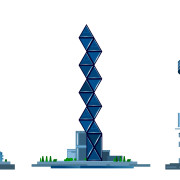- Science News
- Engineering
- 4 articles you need to check out on the future of building engineering
4 articles you need to check out on the future of building engineering
By Colm Gorey, Science Communications Manager

Image: Robert Kneschke/Shutterstock.com
The infrastructure that makes up our towns and cities is undergoing a technological and scientific revolution. Now, to help shine a light on some of these significant changes and what it means for engineering, Frontiers highlights just four of the latest research articles helping shape the future of construction.
For most of the last century, humanity as a species was focused almost solely on building larger cities as fast as possible and with little thought on its impact to the environment. Now, with the climate crisis an unavoidable reality, this old style of thinking is being replaced by not only more sustainable engineering practices, but ones that revolutionize our very understanding of how we build.
Here are just four recent articles published to Frontiers from some of the top researchers in their field as part of the Research Topic 'Horizons in Built Environment'.
Comprehensive review on the dynamic and seismic behavior of flat-bottom cylindrical silos filled with granular material
Storage containers of bulk material are known as bins, silos or even bunkers. Although there is no globally accepted definition for each of the previous terms, ‘bins’ or ‘bunkers’ are commonly used to refer to squat containers with a shallow filling condition of a variety of material like coal, ore, gravel and crushed stones, while slender containers of food supplies (such as wheat or corn) and cement are usually called ‘silos’.
However, several earthquakes that occurred in the last decades have had catastrophic consequences on storage facilities and mainly silos. Not only that, but these silos are very sensitive to human made mistakes and construction errors, as well as to damages occurred during shipment and transportation.
Researchers from Italy recently published a paper in Frontiers in Built Environment that provided a comprehensive summary of the mainly acknowledged experimental and theoretical advances in the dynamic and seismic behavior of silos.
Article link: https://www.frontiersin.org/articles/10.3389/fbuil.2021.805014/full
Graph rewriting techniques in engineering design
Capturing human knowledge underlying the design and engineering of products has been among the main goals of computational engineering since its very beginning.
Over the last few decades, various approaches have been proposed to tackle this objective. Among the most promising approaches is the application of graph theory for representing product structures by defining nodes representing entities and edges representing relations among them.
As a data structure, graphs provide a rich foundation to represent engineering product models with entities of arbitrarily abstract and concrete meaning. In the same context, the manipulation of graphs was investigated for decades and proven to be powerful for complex problems in various domains. Most prominently, the method of graph rewriting is well established to capture manipulation patterns in the form of rules.
Researchers from the Technical University of Munich, Germany published a review article in Frontiers in Built Environment that provides an overview of the current state-of-the-art in graph rewriting and its applications in engineering design, with a focus on the built environment.
Article link: https://www.frontiersin.org/articles/10.3389/fbuil.2021.815153/full
Machine learning in structural design: An opinionated review
Artificial intelligence (AI) has transformed many aspects of our lives, and engineering is no different. While logic-based AI systems has been used to carry out design explorations since the 1980s, the advent of low-cost data collection and processing capabilities have granted new impetus and a degree of ubiquity to AI-based engineering solutions.
Writing in a review paper to Frontiers in Built Environment, Dr Christian Málaga-Chuquitaype of Imperial College London, UK discussed the use of machine learning (ML) in structural design.
He noted that while ML algorithms have been shown to increase design diversity, data requirements will continue to be a limiting factor, particularly in the structural engineering field.
Article link: https://www.frontiersin.org/articles/10.3389/fbuil.2022.815717/full
Predicting the response of laminated composite beams: A comparison of machine learning algorithms
In a paper published to Frontiers in Built Environment, researchers based in Greece used several machine learning regression models for the prediction of the deflection of symmetric laminated composite beams subjected to a uniformly distributed load.
Training, validation, and testing of the models require large amounts of data that cannot be provided by the scarce experiments. Instead, they used ample amounts of data generated numerically using a refined higher-order beam theory for various span-to-depth ratios and boundary conditions, by appropriate discretization of all pertinent geometric and material properties.
Article link: https://www.frontiersin.org/articles/10.3389/fbuil.2022.855112/full
REPUBLISHING GUIDELINES: Open access and sharing research is part of Frontiers’ mission. Unless otherwise noted, you can republish articles posted in the Frontiers news site — as long as you include a link back to the original research. Selling the articles is not allowed.







